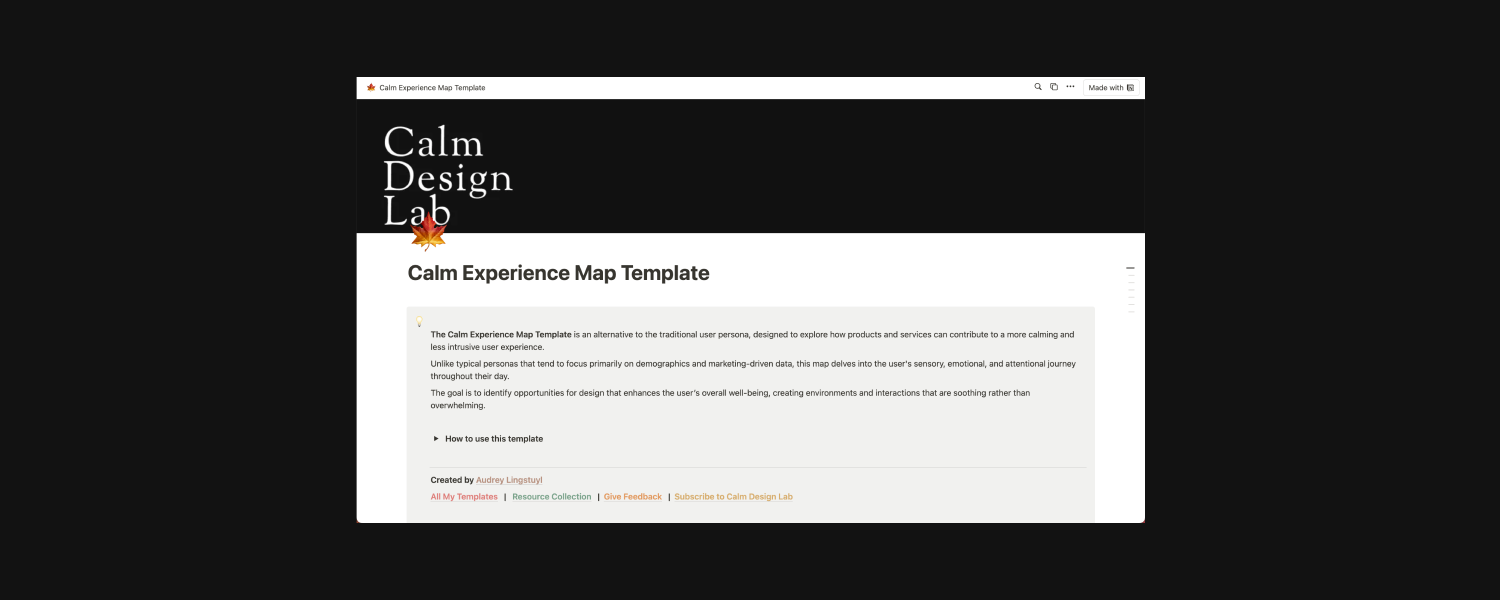IMAGE by Geronimo Giqueaux
For many neurodivergent people, calm isn’t a preference. It’s a form of access.
A few months ago, I released a set of Notion templates exploring calm design methods for mapping user experiences beyond the usual metrics. Instead of demographics and goals, these tools focused on sensory, emotional, and attentional dimensions. One of them, the Calm Experience Map, was meant for UX and service designers looking to uncover opportunities for more mindful, less overwhelming interactions.
Then someone used it in an entirely different way.
A person with ADHD and autism reached out to say the template helped them better understand how they relate to the world. They weren’t designing a product. They were navigating their own experience:
I’m newly diagnosed with autism, and also have ADHD. I have difficulties with discerning my own feelings, so have never paid much attention to my sensory sensitivities (although I definitely have many.) This is such a useful tool for helping me ask the right questions of myself, in order to understand my experience in the world & learn how to better navigate my mental health within it. I haven’t found any other comparable options available in Notion templates, so this is a rare find that I am very grateful for!
This kind of feedback reminded me why I design tools like these in the first place. Not to predict behavior, but to hold space for it.

The “Calm Experience Map Template” offers an alternative to traditional user personas, focusing on designing for a more calming and less intrusive user experience.
Beyond Personas: Mapping Sensory and Attentional Experience
Traditional design methods often rely on fictional personas, journey maps, or optimization goals. These frameworks can be useful, but they tend to generalize or flatten real human experience. Especially when it comes to people whose perception and processing of the world diverge from the norm.
The Calm Experience Map was designed as a counterpoint. It asks: What does it feel like to be in a space? What sensations dominate? What drains or restores attention? What emotional cues are at play? It doesn’t look for the fastest path through a journey, but for the emotional weather along the way.
It turns out, this kind of mapping resonates deeply with neurodivergent users. Not just as a research method, but as a reflective tool.

IMAGE by Geronimo Giqueaux
Why Calm Matters in Neurodivergent Design
Neurodivergence is often characterized by differences in sensory processing, emotional regulation, and attention management. People with autism, ADHD, sensory processing disorders, or anxiety frequently describe feeling overstimulated by environments that were not designed with them in mind.
Interfaces that demand rapid decisions, physical spaces that overload the senses, services that lack predictability, these aren’t just inconvenient. They can be alienating, or even exhausting.
When we think of calm design as a sensory and attentional practice, we begin to see how it can make a difference. It’s not about making things minimalist. It’s about making them navigable.
Designing for Sensory Regulation and Cognitive Load
Research in neurodiversity, particularly around ADHD and autism, shows that overstimulation and unpredictability are often key sources of distress. Interfaces and environments filled with flashing notifications, sudden changes, or unclear structures can trigger overwhelm and shutdown, or create a cognitive maze that drains energy from the actual task at hand.
Calm design doesn’t mean removing stimuli altogether. It means crafting experiences that respect the nervous system. Predictable patterns, clear spatial hierarchies, consistent typography, and stable layouts help reduce cognitive friction without flattening the richness of interaction. This is not minimalism for minimalism’s sake. It’s intentional quiet that holds space for different ways of processing.
Tools like timed reveals, layered information, and rhythmic feedback can support executive functioning. For instance, interfaces that allow users to customize notification rhythms or turn off animations offer autonomy and sensory control. These adjustments aren’t “nice to have”. For many, they are the difference between access and exclusion.

IMAGE by Geronimo Giqueaux
Designing for Plurality, Not Efficiency
Designing for neurodivergence asks us to let go of the default user. To recognize that what overwhelms one person may soothe another. That clarity doesn’t mean the same thing to everyone. It means trading efficiency for flexibility. Optimization for spaciousness.
Calm design invites us to create tools and systems that ask different questions. Not only “What does the user want to do?” but also “How do they feel being here?” Not just “What’s the conversion rate?” but also “Is this a place where someone can think, pause, reflect?”
This shift is not about making things slower. It’s about making room for different ways of being.
Holding Space
That’s what the Calm Experience Map ended up doing. Not because it was designed for neurodivergent people specifically, but because it allowed for attentional self-awareness. It helped someone see themselves in the system.
In the end, calm design is not just about products. It’s about creating conditions where people can show up as they are. Where their ways of perceiving, processing, and being are not just tolerated, but welcomed.
Sometimes, the most radical thing design can do is to listen quietly, and hold space.


